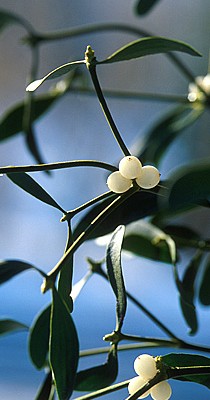
Mistletoe the Parasite
Mistletoe is a parasitic plant that directly derives almost all of its nutrition from other flowering plants. By parasitizing other plants, they have a competitive advantage over many other forms of life because they do not have to compete in soil for their water and nutrient needs. This description of mistletoe sounds surprisingly similar to how cancer operates. When you look at mistletoe growing on a tree it looks very much like a tumour. Cancer gets all of its nutrition from other cells within the human body and it has a competitive advantage because it does not abide by the same rules as other cells in the body.
It turns out the mistletoe can be used to effectively treat cancer, even in advanced cases1,2,3. In North America this is often considered a “fringe treatment” yet if you go to Germany this is a mainstream therapy that is well established by the scientific community. The use of mistletoe dramatically reduces the side effects associated with chemotherapy and radiation. The effects are so dramatic that some countries have already made this the standard of care for cancer treatment. The use of mistletoe as the new standard of care was of huge financial benefit to these countries because of the significant decrease in complications from chemotherapy and radiation.
Although there are several different ways to administer mistletoe, the most common is regular subcutaneous injections. This involves the use of small insulin needles and injecting the mistletoe just under the skin. After injecting the mistletoe lectins the immune system immediately begins to attack the injected fluid resulting in a small red rash around the injection site. This immune activation is an excellent outcome in the context of cancer. By activating the immune system at the site of injection it consequently activates the immune system in the entire body.
Mistletoe has been shown to stimulate increases in the number and the activity of several types of white blood cells4. Immune-system-enhancing cytokines, such as interleukin-1, interleukin-6, and tumor necrosis factor -alpha, are released by white blood cells after exposure to mistletoe extracts5,6. Other evidence suggests that mistletoe exerts its cytotoxic effects by interfering with protein synthesis in target cells and by inducing apoptosis7.
Just like any cancer therapy it is essential that it is used in the right context. When this therapy is used there will initially be a swelling of the tumour, this is a consequence of the immune activation. If there are any detectable masses contained within the skull, then clearly swelling is not desirable. Mistletoe therapy is contraindicated in patients that have any detectable mass in the brain. It also must be used with caution on patients that are are cachexic and malnourished. The sudden release of cytokines associated with immune activation can worsen the malnourished state.
Mistletoe therapy only costs approximately $250 dollars per month and it can be used in conjunction with other medical therapies. I regularly use mistletoe with my patients at the clinic and it is an effective cancer therapy when used appropriately. On a regular basis I see patients improve when they use this therapy as part of a comprehensive integrative cancer therapy. Contact Yaletown Naturopathic Clinic to see if this is the right therapy for you.
Dr. Adam McLeod is a Naturopathic Doctor (ND), BSc. (Hon) Molecular biology, First Nations Healer, Motivational Speaker and International Best Selling Author. He currently practices at his clinic in Vancouver, British Columbia where he focuses on integrative cancer care. https://www.yaletownnaturopathic.com
References:
1. Mistletoe. In: Murray MT: The Healing Power of Herbs. Roseville, Calif: Prima Publishing, 1995, pp 253-9.
2. Samtleben R, Hajto T, Hostanska K, et al.: Mistletoe lectins as immunostimulants (chemistry, pharmacology and clinic). In: Wagner H, ed.: Immunomodulatory Agents from Plants. Basel, Switzerland: Birkhauser Verlag, 1999, pp 223-41.
3. Hajto T, Lanzrein C: Natural killer and antibody-dependent cell-mediated cytotoxicity activities and large granular lymphocyte frequencies in Viscum album-treated breast cancer patients. Oncology 43 (2): 93-7, 1986.
4. Büssing A, Regnery A, Schweizer K: Effects of Viscum album L. on cyclophosphamide-treated peripheral blood mononuclear cells in vitro: sister chromatid exchanges and activation/proliferation marker expression. Cancer Lett 94 (2): 199-205, 1995.
5. Hajto T: Immunomodulatory effects of iscador: a Viscum album preparation. Oncology 43 (Suppl 1): 51-65, 1986.
6. Hajto T, Hostanska K, Frei K, et al.: Increased secretion of tumor necrosis factors alpha, interleukin 1, and interleukin 6 by human mononuclear cells exposed to beta-galactoside-specific lectin from clinically applied mistletoe extract. Cancer Res 50 (11): 3322-6, 1990.
7. Mengs U, Schwarz T, Bulitta M, et al.: Antitumoral effects of an intravesically applied aqueous mistletoe extract on urinary bladder carcinoma MB49 in mice. Anticancer Res 20 (5B): 3565-8, 2000 Sep- Oct.






Leave a Reply
You must be logged in to post a comment.